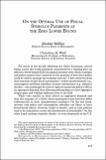| dc.contributor.author | McKay, Alisdair | |
| dc.contributor.author | Wolf, Christian K. | |
| dc.date.accessioned | 2024-12-05T18:49:30Z | |
| dc.date.available | 2024-12-05T18:49:30Z | |
| dc.date.issued | 2024 | |
| dc.identifier.isbn | 9789567421749 | |
| dc.identifier.isbn | 9789567421732 (digital) | |
| dc.identifier.issn | 0717-6686 (Series on Central Banking, Analysis, and Economic Policies) | |
| dc.identifier.uri | https://hdl.handle.net/20.500.12580/8025 | |
| dc.description | For much of the decade following the Great Recession, central banks across the world remained constrained by a binding zero (or
effective) lower bound (ZLB) on nominal interest rates. Much academic and policy interest thus centered on the question of how fiscal policy could be used to manage the economy instead.1 A key takeaway from that literature is that fiscal instruments—either unconventional (e.g., consumption and labor subsidies) or more conventional (e.g., stimulus checks)—can in principle be used to replicate monetary policy’s effects on aggregate demand, thus allowing policymakers to close aggregate output gaps and stabilize inflation even at the ZLB. | es |
| dc.description.abstract | For much of the decade following the Great Recession, central banks across the world remained constrained by a binding zero (or
effective) lower bound (ZLB) on nominal interest rates. Much academic and policy interest thus centered on the question of how fiscal policy could be used to manage the economy instead.1 A key takeaway from that literature is that fiscal instruments—either unconventional (e.g., consumption and labor subsidies) or more conventional (e.g., stimulus checks)—can in principle be used to replicate monetary policy’s effects on aggregate demand, thus allowing policymakers to close aggregate output gaps and stabilize inflation even at the ZLB. | es |
| dc.format | .pdf | |
| dc.format.extent | Sección o Parte de un Documento | |
| dc.format.medium | p. 275-300 | |
| dc.language.iso | en | es |
| dc.publisher | Banco Central de Chile | es |
| dc.relation.ispartofseries | Series on Central Banking Analysis and Economic Policies; no. 30 | |
| dc.rights | Attribution-NonCommercial-NoDerivs 3.0 Chile | * |
| dc.rights.uri | http://creativecommons.org/licenses/by-nc-nd/3.0/cl/ | * |
| dc.subject | RECURSOS FISCALES | es |
| dc.title | On the optimal use of fiscal stimulus payments at the zero lower bound | es |
| dc.type.doc | Artículo | |


